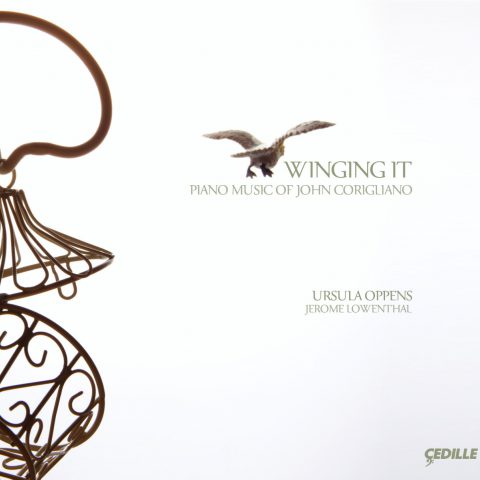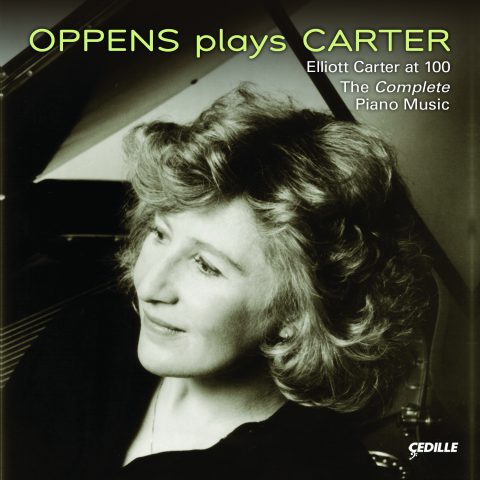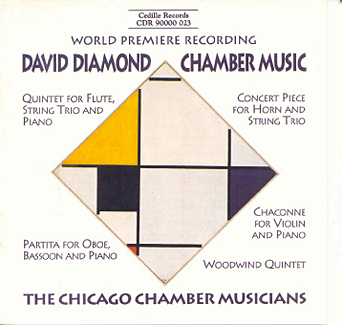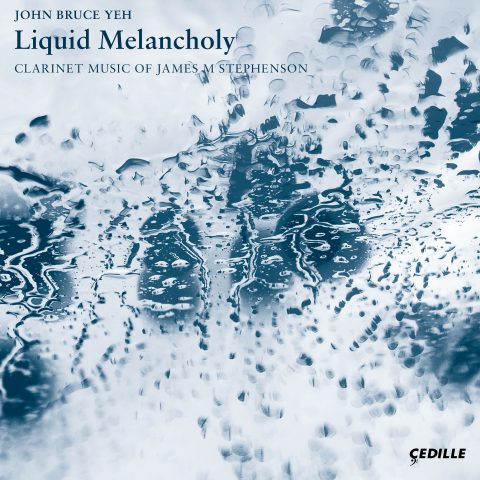Store
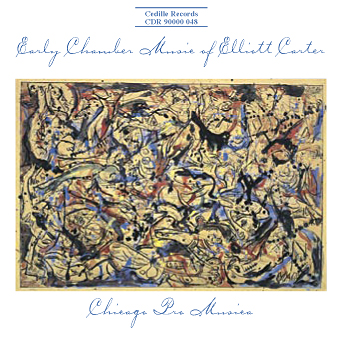
Store
Early Chamber Music of Elliott Carter
John Bruce Yeh, Alex Klein, Barbara Haffner, Easley Blackwood
This CD of Elliott Carter’s adventurous early chamber music is designed to appeal to newcomers, as well as aficionados of this renowned contemporary American composer. “Early Chamber Music of Elliott Carter stands out amid Carter CDs because it’s accessible from beginning to end,” says producer Jim Ginsburg. “The selections are certainly substantial enough to appeal to the composer’s hard-core fans, but without discouraging the uninitiated.” The pieces, from 1945 to 1950, are “early” in the body of work that made Carter (1908-2012) famous, not the products of a novice composer.
The beginnings of Carter’s signature style are evident in these works. “Both musically and chronologically, they occupy a tantalizing middle ground between wartime populism and postwar modernism,” Stephen Heinemann writes in the booklet notes.
Preview Excerpts
ELLIOTT CARTER (1908-2012)
Woodwind Quintet
Sonata for Cello and Piano
Eight Etudes and a Fantasy for Woodwind Quartet
Artists
4: with Barbara Haffner, cello
Program Notes
Download Album BookletEarly Chamber Works by Elliott Carter
Notes by Stephen Heinemann
Elliott Carter has been identified with musical modernism for so long that his involvement in the mid-century nationalistic movement of composing accessible, audience-centered music is often overlooked. The four works on this recording — Pastoral for clarinet and piano, composed in 1940; Woodwind Quintet and Sonata for Cello and Piano of 1948; and Eight Etudes and a Fantasy for woodwind quartet, from 1950 — represent, in varying degrees, Carter’s break from nationalism and re-engagement with the kinds of music that had originally instigated his interest in composition. Through these works, Carter began to glimpse new possibilities for musical discourse that he has courageously real- ized over the rest of his long and productive career, earning his reputation as America’s most important composer.
Carter has identified several factors as significant to the development of-his musical individualism: the end of the Second World War (a “disintegration” unlike the climax of the First, in his estimation); a rediscovery of his love for the formidable works of Stravinsky, Schoenberg,-Bartók, and Varèse; and (perhaps most crucially) what he perceived as the-poor reception accorded his attempts to write music that would attain-popularity — an ambition that was being realized, in spades, by Aaron-Copland. He would recall, many years later, “I finally said the hell with that whole point of view and decided to write what I really always hoped to write, and what I thought was most important for me. I’ve taken that point-of view ever since.”1 The sublimation of his own erudition (in many matters, not just musical), the imitation of fashionable styles, and eventually even a concern for the apparent playability of his works — all disappeared with his realization that Copland’s way (which had come to be regarded as the American way, if not the American way) would not be Carter’s as well. New vistas of creative possibilities opened to him; his musical mind was liberated.
Carter’s most representative music is certainly highly-complex. It is unfortunate that for much of the-concert-going public, complexity — an admirable quality in Bach or Mahler — is regarded as an insurmountable barrier when it comes to enjoying contemporary works. Carter has said, “One thing I can’t understand — it-always has remained a puzzle to me — is why people have such trouble with-modern music. It seems to me to be perfectly intelligible. When I hear one-of my pieces again, or listen to the Early Chamber Works by Elliott Carter Notes by Stephen Heinemann record, I don’t see how people could-find this perplexing in any way. Yet audiences can’t make head or tail of-it.”2 A Catch-22 of-creative activity is that a new work is never expe- rienced through a tabula-rasa by its creator, but the sophistication of Carter’s methods is not-wedded to arcane pretexts. His music is multi-leveled and dramatic,-intricately plotted in structural detail and thoughtfully enacted in-instrumental character. Untainted by condescension, it radiates intelligence and integrity, and its complexity transcends mere complicatedness.
This recording may therefore serve complementary purposes. We call these “early” chamber works, but they are fully mature pieces in their own right.-Both musically and chronologically, they occupy a tantaliz- ing middle ground-between wartime popu- lism and postwar modernism. As such, they form a path to-be profitably retraced, and are simultaneously a commencement and a-summation — an introduction to and a retrospective on facets of the-composer’s artistry. For example, it is hard to imagine that a musical-palette consisting entirely of rhythmically identical ascending halfsteps-could yield a compelling composition. Yet that modernistically rigorous-constraint, when filtered through Carter’s inventiveness, results in the-energetic and clever Etude IV, as exoteric and delightful a piece as any-created solely with populism in mind.
Time has long been regarded as a precondition of music, just as space is a-precondition of sculpture. The conception of time as a medium, itself to be-manipulated, has become crucial to Carter’s compositional technique. This is evidenced in many ways, notably in the areas of polyrhythm and metric-modulation.
Polyrhythm, the simultaneous presentation of different pulses, has been a compositional staple for centuries. Its conception and breadth of realization in Carter’s music is unique, however. In compositions beginning with the Cello Sonata, Carter frequently employs more than one tempo at a time, forming a counterpoint of speeds in which none predominates. In later works, a single huge polyrhythm may even cut across an entire piece: the central tempo (analogous to the central pitch, or tonic, in the tonal tradition) is displaced by competitive forces.
Metric modulation is Carter’s-most famous innovation, although probably not his most important. (We must take care not to overemphasize its significance: the composer once walked out on a conductor’s pre-performance demonstration.) It makes-its first notable appearances in the Cello Sonata. The technique — more-properly called speed modulation, since the meter itself may remain constant-— involves the seamless, systematically controlled change of tempo. It often-occurs almost imperceptibly but is clearly audible in, for example, the-final movement of Eight Etudes and a Fantasy: a fugue subject is presented in the clarinet and bassoon at one speed-and then, after the pulse has been redefined, half again faster in the-flute.
In The Rite of Spring, the Stravinsky masterpiece that impelled Carter-into composition, the profound innovations of both rhythm and harmony are-fully symbiotic. Carter would likewise discover that his own emerging-rhythmic practice could not be expressed adequately through neoclassical-harmony. (Even his populist works tended to sound more harmonically-adventuresome than those of his colleagues.) His trajectory toward a-convincing and inventive atonality is clearly on display in this program. The harmonic environment pre- sented by the first-movement of the Cello Sonata and the Fantasy is very different from that of Pastoral, but this environment is by no-means hostile. To be sure, a full enjoyment requires a different perspec- tive, but one that is rewardingly achieved through repeated, attentive-listening.
The core of Carter’s craft is not found in rhythm or harmony, however, but in counterpoint. In its strictest musical sense, counterpoint is the art of-combining melodies; in a communicative sense it refers to the-evocation of opposition. Both senses apply equally well to Carter. For him, counterpoint is much more than a matter of texture or-technique — it is his music’s central metaphor. Following his education at-Harvard, Carter, like Copland, studied in France with Nadia Boulanger. Unlike Copland, Carter’s focus was less on com- position than on counterpoint. This focus would inform every aspect of his creative imagination, extending-beyond melody and harmony to rhythm (hence the enhanced role of polyrhythm)-and eventually to the dialectical character of his works. Carter recalls that “at a certain point I decided that the traditional categories,-like ‘theme and accompaniment’ or ‘subject and countersubject,’ really didn’t deal with what began to seem to me the vast spectrum of kinds of-relationships that [musical elements] can have with each other.” He-began “to think in terms of simultaneous streams of different things going-on together, rather than in the usual categories of counterpoint and-harmony.”
Under these circumstances, a Carter poly- rhythm may be realized not simply as-dif- ferent pulses but as different kinds of time. For example, he describes-the opening of the Cello Sonata as “the piano playing a kind of clock time-and the cello a kind of psychological time”4 — forming a simultaneity not only-of melodic lines but also, more crucially, of musical characters: the mechanistic piano is counterpointed by the rhapsodic cello. From this point on, as David Schiff has noted, “the stylistic contrasts and-contradictions that had marked Carter’s music from the beginning turned into-a new kind of counterpoint; style became structure.
PASTORAL
On first hearing, Pastoral would not seem to participate in this stylistic progression.-True to its title, its relatively calm quality contrasts with-the agitation of most of Carter’s works. Carter describes Pastoral-as “a sort of continuous melodic line which takes on different characters as-it unwinds 6 . . . I’ve come to realize that in many ways it’s quite an individual piece, perhaps even novel in the way it treats the [solo instrument] and the piano.-Though it’s obviously rather selfconsciously modernistic, being almost all-in 5/8 time.”7 Of particular interest is how the second-theme evolves from preceding material rather than entering in contrast to-it.
Originally composed for English horn with piano accompaniment, Carter-configured Pastoral’s solo part also for viola (for-which it was first published) or clarinet (the ver- sion most frequently-recorded).
WOODWIND QUINTET
Carter dedicated this piece to Nadia Bou- langer, conceiving it as the kind of music he believed she wanted him to-write. He recounts, “I was asked by a flutist . . . to-write a woodwind quintet. And when I had finished it, his group couldn’t-play it. It was too hard and too complicated for them. I was very-discouraged by that, especially since I had attempted to write a piece that-I thought they could play — that’s partly why it’s more like my earlier-music.
Although he considers the Quintet somewhat retrogressive, Carter notes, “I also attempted to individualize each instrument, assigning a different-character to each one, and that procedure anticipates some of my later-writing.”9 This individualization is particularly striking at the very beginning of-the piece. The second movement pro- vides a clear-display of the influence of jazz on Carter. Rather than give a shallow-approximation of a swinging rhythmic feel (as some other composers have done), Carter appropriates its characteristic syncopations and uses continuous motivic-development to put his own signature on them.
CELLO SONATA
Completed on December 11, 1948, his fortieth birthday, the-four-movement Cello Sonata was Carter’s breakthrough piece. There are still-significant reminders of his neoclassicism — including the entire second movement, which he actually composed first — but the melodic, harmonic,-contrapuntal, and aesthetic concerns that have preoccupied him over the-ensuing fifty-plus years yield their first solutions here. It is a work of-moderate length and astonishing breadth, dramatic in its presentation and-novel in its form.
The cello and piano first appear as adversaries; the question of their-reconciliation forms the dialectical foundation of the piece. (Part of Carter’s-triumph is his ability to present contrary musical gestures simultaneously,-yet meld them into a convincing whole. His collisions do not have the “accidental” quality of Charles Ives’s.) In the first movement, the-mechanistic character of the piano is reflected through terse motivic-figures, while the humanistic cello spins long, impassioned-quasi-improvisa- tions. The second movement is a thrilling, intense Vivace-that recalls the Woodwind Quintet. As Schiff has observed, it is-Cart- er’s last work (to date) to employ a key signature. The third movement-is an Adagio with intensity and contradiction to match the first; the-fourth, an imposing Allegro. Each movement begins with material adapted-from the conclusion of the previous one, the fourth wrapping around to the-first with the instrumental roles reversed.
EIGHT ETUDES AND A FANTASY
Unlike some well-established composers, Carter truly enjoys teaching his-craft: “I think it’s extremely illuminating, about the problems of-composition, to have students.”10 This attitude stems in part from Carter’s-studies with Boulanger, who instilled an appreciation for craftsmanship: “the idea of paying very strict attention to all aspects-of a composition and making everything in the music seem to be very valuable-and important,”11 a lesson inculcated through instruction in-counterpoint.
While teaching an orchestration class at Columbia University in 1949, Carter-assigned problems of both composition and instrumentation. The assignments-may have discouraged his students, but they focused Carter’s attention-wonderfully and provided the impetus for Eight Etudes and a Fantasy for-flute, oboe, clarinet, and bassoon. As Schiff notes, “The Etudes became-stud- ies for Carter as well as his students. By isolating specific-compositional problems he discovered many of the techniques that would-become the basis of his mature style.”12 Carter appended the Fantasy as a-brilliant summation of the Etudes.
The precise wording of the compositional problems is not recorded, but might have been along the following lines: Etude I: Criss-cross the individual instruments, overlapping their registers to maximize the variety of timbre. Etude II: Repeat a virtuosic figure in all instruments. Displace it subtly to render it out of phase with itself. Etude III: Sustain a rudimentary major triad and generate interest by changing its instrumental color.
Etude IV: Use only an ascending half-step in eighth notes, followed by a-silence of variable length. (Carter calls the resultant texture a mosaic,-since the individual blocks of sound are essentially identical. The-greater sensation is that of a moiré effect: the differing combinations produce a variety of larger, fascinating shapes — including scales,-registral explorations, polyrhythmic ostinatos — but the original blocks are always clearly present.) Etude V: Follow the instructions for Etude I, but focus on registers not considered idiomatic in terms of sound quality or overall balance. Etude VI: Employ unusual instrumental effects. (Carter is a brilliant orchestrator, but one for whom unusual effects must always be at the service of more substantial musical details. The “special effects” used here are limited to flutter-tonguing and harmonics; this étude would sound very different if composed today.) Etude VII: Follow the directions for Etude III, but restrict the pitch material to just one note: the G above middle C. To compensate for this restriction, make the étude vibrant by changing colors quickly. Etude VIII: Create the illusion of a larger ensemble by juxtaposing two motives displaying maximum contrast. (The first motive is a tiny sonic whirlwind, the second a stabbed single note; each is tossed quickly from player to player.)
The Fantasy is Carter’s cumulative final exam for himself. It begins in the-style of a fugue (his last significant essay in strict imitative counterpoint), with subject derived from the sixth, eighth, and first-études. This gives way to the reintroduction of ideas from other études, brilliantly-facilitated via metric modulation.
The irony of Elliott Carter’s accomplish- ment is that he has not abandoned-nation- alism — he has helped redefine it. As he observes, “If-my music is considered American, it’s because it’s my music and because I’m-an American. I don’t think it’s the other way around. The character of-American society and culture is so diffuse and so con- fusing that nowadays-it’s nearly impossible to label a composer American at all . . . I’ve never in-recent years thought about it as being American; I just thought I’d rather-write the music that I liked and that I thought it was important to write.-That may be an American way of thinking in itself
Album Details
Total Time: 57:12
Recorded: July-Aug 1997, Dec 1998, Mar 1999 at WFMT, Chicago, IL
Producer: James Ginsburg
Engineer: Bill Maylone
Cover: Jackson Pollock, Untitled (c. 1945). Private collection.
Design: Cheryl A Boncuore
Notes: Stephen Heinemann
© 1999 Cedille Records/Cedille Chicago
CDR 90000 048
